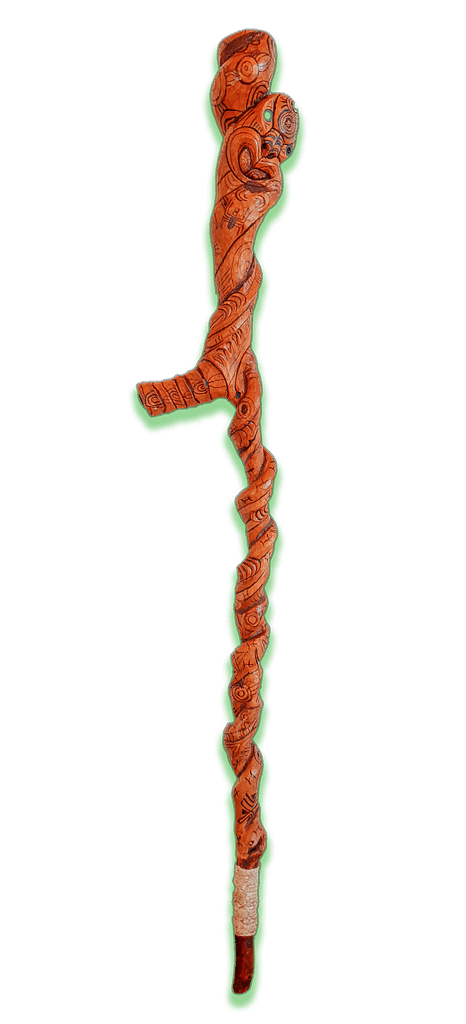
PEPEHA
Tihei mauri ora
Ko IO te matua
Ko Hine Moana raaua ko Taawhirimaatea raaua ko Taane Mahuta ngaa atua
Ko te tiirairaka me te kahu me te aihe me te tooroa ngaa kaitiaki
Ko Te Mai a Rere Kohatu ngaa tupuna
I te taha matau
Ko Pakia ki Pukerangatira ki Tauwhare te maunga
Ko Hokianga te moana
Ko Matawhaorua te waka
Ko Punehu te awa
Ko Te Rarawa te iwi
Ko Waiwhatawhata me Waiparera ngaa marae
Ko Tahaawai te hapu
Ko Paiha te whaanau
I te taha maaui
Ko Takitimu ngaa maunga
Ko Awarua te moana
Ko Oreti te awa
Ko HMS Endeavour te waka
Ko Groves te hapu
Ko Fox te whaanau
Ko Tony Bridge toku ingoa.
I te taha wairua
Ko Koromatua te maunga
Ko Roto-Uua te moana
Ko Waiau te awa
Ko Te Kowhai te marae
Ko Uruao te waka
Ko Waitaha te iwi
Ko Rapuwai te hapu me te whaanau
Ko Te Waenga toku ingoa
Following songlines
For we Maaori, whakapapa is everything. It defines us and tells us who we are. We look into the swirling mists of things yet to come with our eyes upon what has passed. We stand on the shoulders of our tupuna, uplifted by them so we can stare over the parapet of the present into the future.
On the top row of the bookshelf in my lounge is an old photograph, framed in white and sitting on a small wooden easel. It is a portrait of my mother and father on their wedding day. Both are smiling at the camera. My father, smooth and sophisticated in a double-breasted suit and Brylcreemed centre-parted hair, is channelling his inner Clark Gable. Beside him, my mother floats ethereally in a gauzy, glowing froth of white, lace and elbow-length gloves. My father’s grin is broad, confident and compelling; my mother’s smile is a little quieter, with that curious lopsidedness she would display throughout the rest of her life.
Nevertheless, both appear happy with their decision to face the future together. My father has travelled south from the Hokianga Harbour in Northland to Tapanui in Southland via World War II and a New Zealand Forest Service career. He has met my mother at a dance in Invercargill. In her early thirties, she has been swept off her feet by his good looks and charm.
Each time I study that photograph, it reminds me of the journeys all my tupuna (ancestors) have made, that I am the intersection of my parents’ songlines.
My mother was born in Invercargill, at the bottom of the South Island of New Zealand. On the other hand, my father was born in the far North of New Zealand, in the Hokianga Harbour.
They brought me into being in the Maniototo area of Central Otago. I was born and raised for my formative years in the gentle company of the trees surrounding our home. Trees have always been places of peace and rest for me, and I have always enjoyed hearing their stories, carried down the wind and pinned to the branches.
When I was nine, our family moved to Canterbury, where I went through school, university and teachers training college before embarking upon a thirty-year career as a secondary school teacher. I began as a French, English and German teacher. However, by the end of my time as a teacher, I was teaching photography and IT.
My mother, a devout Christian, and a very talented writer, always felt I should be either a priest or a writer (or preferably both!). I loved words, and often as a child, I would amuse myself by writing short stories. I much preferred the stricture and intensity of the short story, where every word had to be considered and applied carefully. I loved the idea that you could weave levels and layers of understanding into a single phrase or sentence. So it never occurred to me to write poetry.
My father was not religious; however, his spirituality was rooted firmly in Nature and his understanding of it. From an early age, he would take me with him on work trips into the forest and mountains, and he instilled a deep love of the natural world within me. He also taught me much about surviving in the wilderness and learning to be self-reliant. His greatest gift to me, however, was photography. While my mother had a deep love for words, my father encouraged my ability to see and express that visual understanding of the world. Being Maaori and brought up in a Maaori community, he taught me their worldview without ever consciously telling it like that. From him, I learned to see that all the elements of Nature were intertwined and that they were all sentient living beings. In many ways, trees have always seemed to me to be my wise elder brothers and sisters.
My photographic career probably started around thirty, when I was called upon to develop national curricula for New Zealand secondary schools. From 1990 onwards, I found myself working more and more as a professional photographer, albeit on a part-time basis. Finally, in 2006, I left teaching and took those skills with me on a journey into the world to see if I could survive working for myself.
For a long time, words and pictures existed in separate spaces; I practised one or the other but never both simultaneously.
Then in 2020, during our Level Four lockdown, I found my inner poet on the first morning. Words would come each day, and I would assemble them into a short poem. Then, I would match them with a picture.
A mantra came to me. Words and pictures. Pictures and words. It is a way to weave together the gifts given to me by my ancestors through both parents.
And weave a new songline to honour them.